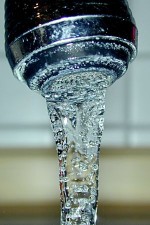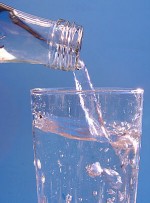How is drinking water purified?
Treating water to make it suitable to drink is much like wastewater treatment. In areas that depend on surface water it is usually stored in a reservoir for several days, in order to improve clarity and taste by allowing more oxygen from the air to dissolve in it and allowing suspended matter to settle out. The water is then pumped to a purification plant through pipelines, where it is treated, so that is will meet government treatment standards. Usually the water runs through sand filters first and sometimes through activated charcoal, before it is disinfected. Disinfection can be done by bacteria or by means of adding substances to remove contaminants from the water. The number of purification steps that are taken depend on the quality of the water that enters the purification plant. In areas with very pure sources of groundwater little treatment is needed.
What dangers can there be in drinking water?
There are several problems that can endanger the quality of drinking water. A number of these problems are summed up here. Someone can detect coliform bacteria in drinking water. Coliform bacteria are a group of microrganisms that are normally found in the intestinal tract of humans and other warm-blooded animals, and in surface water. When these organisms are detected in drinking water this suggests contamination from a subsurface source such as barnyard run-off. The presence of these bacteria indicates that disease-causing microrganisms, known as pathogens, may enter the drinking water supply in the same way if one does not take preventive action. Drinking water should be free from coliform. Yeasts and viruses can also endanger the quality of drinking water. They are microbial contaminants that are usually found in surface water. Examples are Giardia and Cryptosporidium. Giardia is a single cell organism that causes gastrointestinal symptoms. Cryptosporidium is a parasite that is considered to be one of the most significant causes of diarrhoeal disease in humans. In individuals with a normal immune system the disease lasts for several days causing diarrhoea, vomiting, stomach cramps and fever. People with weakened immune systems can suffer from far worse symptoms, caused by cryptosporidium, such as cholera-like illnesses. Nitrate in drinking water can cause cyanosis, a reduction of the oxygen carrying capacity of the blood. This is particularly dangerous to infants under six months of age. Lead can enter the water supply as it leaches from copper pipelines. As the water streams through the pipes, small amounts of lead will dissolve in the water, so that it becomes contaminated. Lead is a toxic substance that can be quickly absorbed in the human systems, particularly those of small children. It causes lead poisoning. Legionella is a bacterium that grows rapidly when water is maintained at a temperature between 30 and 40 degrees for a longer period of time. This bacterium can be inhaled when water evaporates as it enters the human body with aerosols. The bacteria can cause a sort of flue, known as Pontiac fever, but it can also cause the more serious deathly illness known as legionellosis.
How is drinking water quality protected?
All countries have their own legal drinking water standards. These
prescribe which substances can be in drinking water and what the
maximum amounts of these substances are. The standards are called
maximum contaminant levels. They are formulated for any contaminant
that may have adverse effects on human health and each company that
prepares drinking water has to follow them up. If water will be
purified to make it suitable to drink it will be tested for a number of
dangerous pollutants, in order to establish the present concentrations.
After that, one can determine how much of the contaminants have to be
removed and if necessary purification steps can be progressed.
|
 |
|
|||||
|
||||||
|
|
||||||







